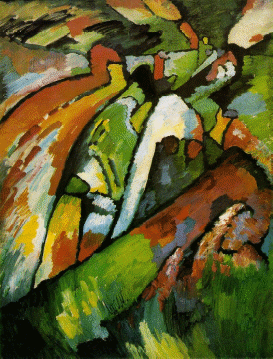Every artistic work is the brainchild of its historic period. What is more important is that art can make our emotions and feelings come out. Each period of time and each culture aimed to produce their own forms of art that would remain unique for ages. Despite temporary and cultural differences, works of art can be subjected to the similarity of spiritual and moral atmosphere and connection between inner feelings and external forms.
As each human is unique in his/her attitude to the artistic world, it is possible to find a particular work that will speak to your spirituality and your unique perception of nature and the real world. In this regard, Kandinsky’s work called Improvisation 7 is the closest fit for my spiritual and emotional world because colors, hues, forms, and shadows perfectly disclose the needs of my soul (see Figure 1).

One cannot deny the fact that “expressive arts offer use tools to move into the depth of our experience and be awakened to the vitality of dynamic expression” (Beckman and Painter 15). Indeed, the work that appeals to my spirituality and my soul also reveals my inner emotions and attitude to the real world. The work fully discovers the notes of my spiritual word. It also discloses my experiences and future prospects and goals.
Interpreting the work of art, Kandinsky’s Improvisation 7 provides a unique language of form and colors. According to the artist, “[t]he artist is the hand, which playing, touching one key or another, to cause vibrations in the souls” (Kandinsky 32). Viewing the painting, hence, it is that a harmony in colors corresponds to vibrations in the human soul. This is why this work of art satisfies my spiritual needs and keeps my mind and soul in harmony.
Improvisation 7 helps me connect my inner feelings with another reality which is far from a material perception. At the same time, the work manages to convey my external experiences related to the real world. The point is that the emergence of inner life at present is only a slight spark of our consciousness. Living in the time of materialism, abstractionism is only a desperate attempt to find another purpose and belief in life. Therefore, this painting also helps me escape from the material world and fill in my soul with spirituality.
Certainly, Kandinsky has many other works revealing abstract worlds, but I have chosen this one because the combination of green and yellow, and blue fits my vibrations of soul. Hence, green symbolizes life and nature, which appeals to me much, various warm yellow and cold blue render the sun rays in a blue sky. As it can be seen, artistic works skillfully combine color, forms, and spirit in a harmonic unit where one component depends on another (Kandinsky 33). It reminds of the human soul that tries to combine material body and feelings.
In conclusion, art can serve as a unique way for rendering the perception of the world. It also helps to restore and define what inner feelings guide you. In this respect, Kandinsky’s Improvisations manages to fill in my soul with all experiences that arose while viewing the inner structure of the world. Moreover, the work speaks to my spirituality and corresponds to the vibration of my soul and unique perception of the real world.
Works Cited
Beckman, Betsey, and Painter, Christine Valters. Awakening the Creative Spirit: Bringing the Art to Spiritual Direction. US: Church Publishing, 2010. Print.
Kandinsky, Wassily. Concerning the Spiritual in Art. US: Kessinger Publishing, 2004. Print.